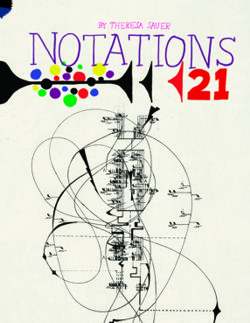 Notations 21
Notations 21
by Theresa Sauer
Mark Batty Publisher
318 pages; $78.00
“We live in an incredible time in music history,” writes Teresa Sauer in her preface to this beautiful book. Sauer has collected scores from a broad range of contemporary composers to celebrate the 40th anniversary of the publication of John Cage’s own collection, Notations. These scores are all remarkably eloquent – even for those who don’t read music. In any case, most of these works do not use traditional notation at all.
Some, like Canadian composer Hope Lee’s Tangram are more readily playable than works like Steve Roden’s Pavilion Score, in which the performers are “mapping the space in sound” and “the audience would be listening to a drawing in sound of the space that they were sitting inside of.” Peter Hölscher’s Das Licht im Dunkel der Wolke and Douglas Wadle’s Amphiboly, work as pieces of visual art. Some made me laugh, like John Stump’s Love Theme from Prelude and the Last Hope in C and C-Sharp Minor. Teresa Sauer’s Parthenogenesis features a picture of a Komodo dragon, whose genetic code forms the basis of her piece. Canadian composer Chiyoko Szlavnics uses the evocative untitled drawings reproduced here as inspiration for her traditionally notated compositions. The notation of A Rose is a Rose is a Round by the influential American composer James Tenney, who taught at York University for many years, reflects back on the form of the piece itself. Two works by Canadian R. Murray Schafer, Epitaph for Moonlight and Snowforms, like many of his scores, show his graphic skills.
Like Cage, Sauer has arranged the scores in handy alphabetical order. But she adds an index and biographical sketches. Whereas Cage’s collection was in black and while, many of the scores in this volume, like Cage’s own Aria, make use of vivid colours.



